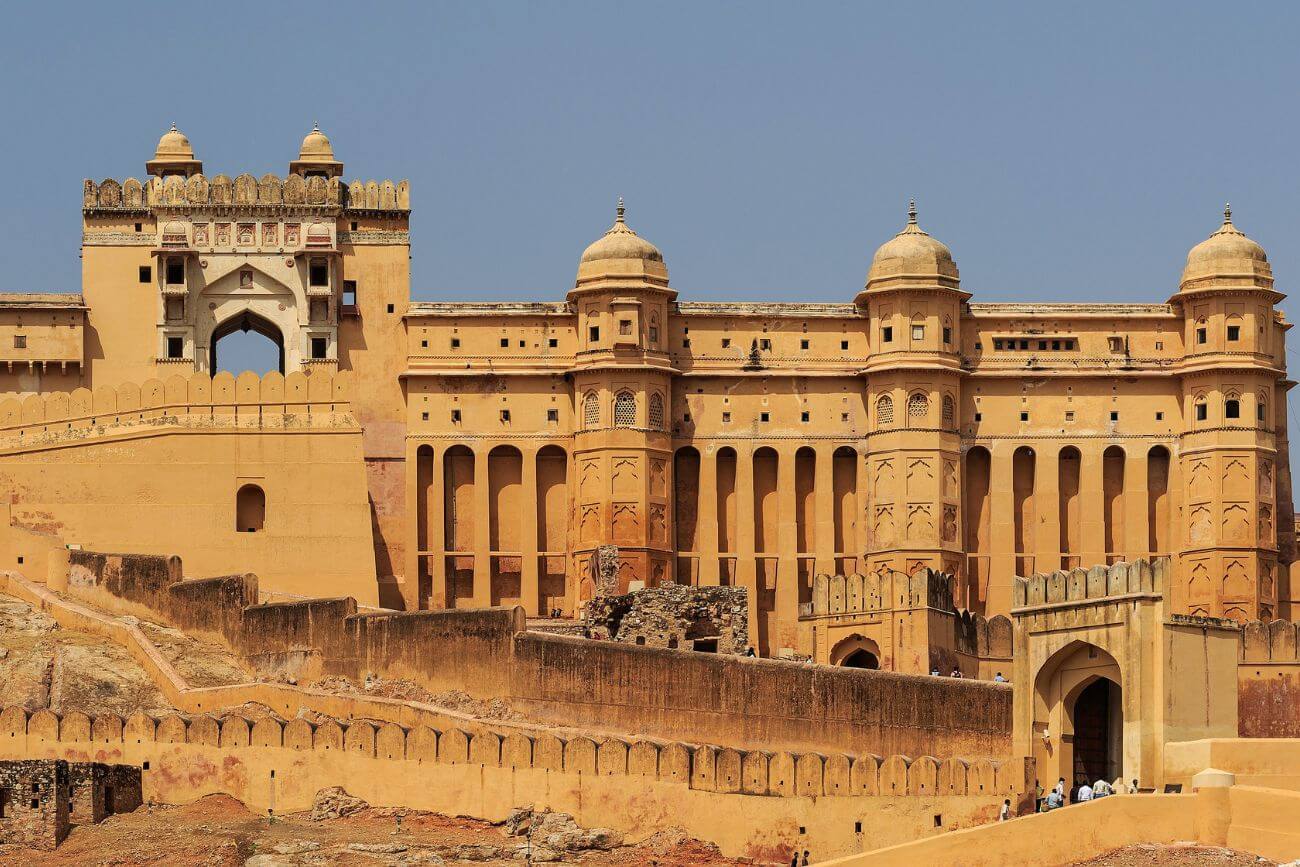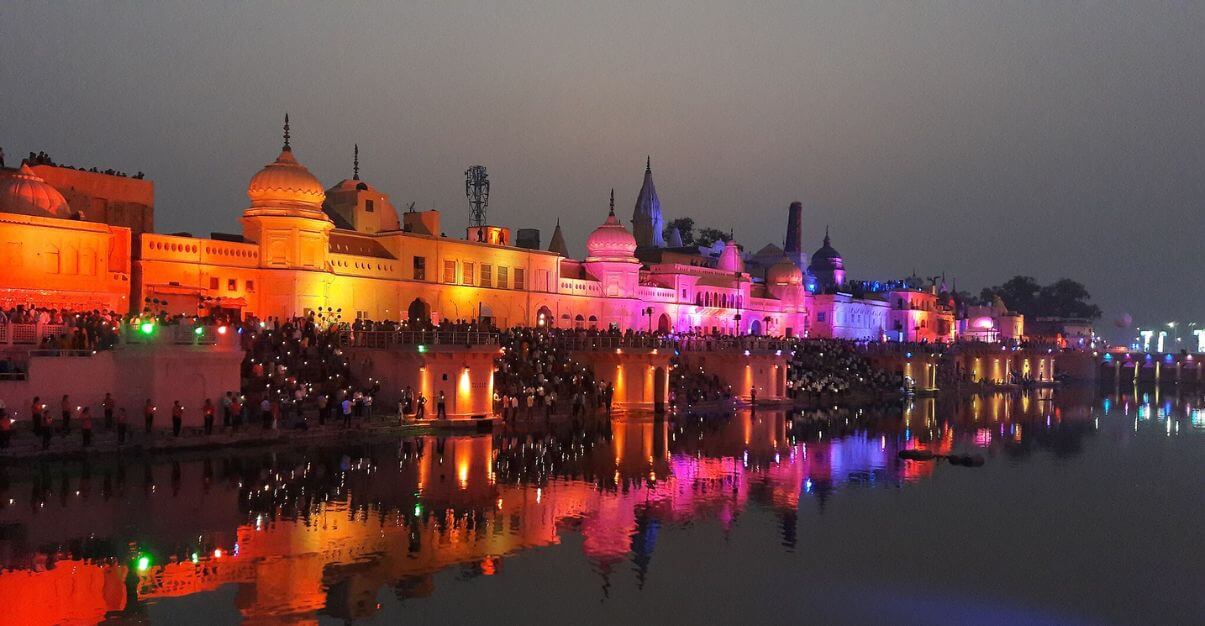The city of Jaipur is one of the most beautiful cities in India. The city has a glorious past, a rich history, and a rich heritage of being the home to the royal kings of Rajasthan. Jaipur has since long been the capital of the Indian state of Rajasthan – the land of the Kings. Today, it is a major metropolitan city, a popular tourist city, and a trade centre in India.
The city got its name from its founder Maharaja Sawai Jai Singh II. He became the king at the very young age of 11 and was trained from very early in arts, science, philosophy, and military affairs. Before founding the Jaipur city, Amer was the capital of the kingdom.
However, because of the scarcity of water, the king planned a new city that followed scientific principles, and the Indian architectural guidelines of Shilpa Shastra.
Later in the year 1876, Maharaja Ram Singh instructed to paint the entire city Pink colour (known to be the colour of hospitality). This was done to welcome the Prince of Wales (Leader King Edward VII). Since then the colour theme has been maintained and the city is known as ‘The Pink City of India’.
Vidhyadhar Bhattacharya, an architect from Bengal assisted the king in planning and establishing the city. Today, the city is a popular tourist destination and is listed as one of the World Heritage Cities.
The city is admired for its historical forts, beautiful palaces and museums, old Jaipur bazaars, and delectable cuisines.
Jaipur City: The home to the royal kings of Rajasthan
Since its inception, Jaipur City and the kingdom of Amber have been the land of the Kings. The royal land witnessed several battles, throning, and diplomacy during the times when the Mughal Empire was at its peak. During all these times, there were gigantic forts built, more forts were built to provide a defence belt to the residential fort, and more.
All these events and years shaped the city as we see it today and there are tremendous things to see and explore in the city.
City Palace
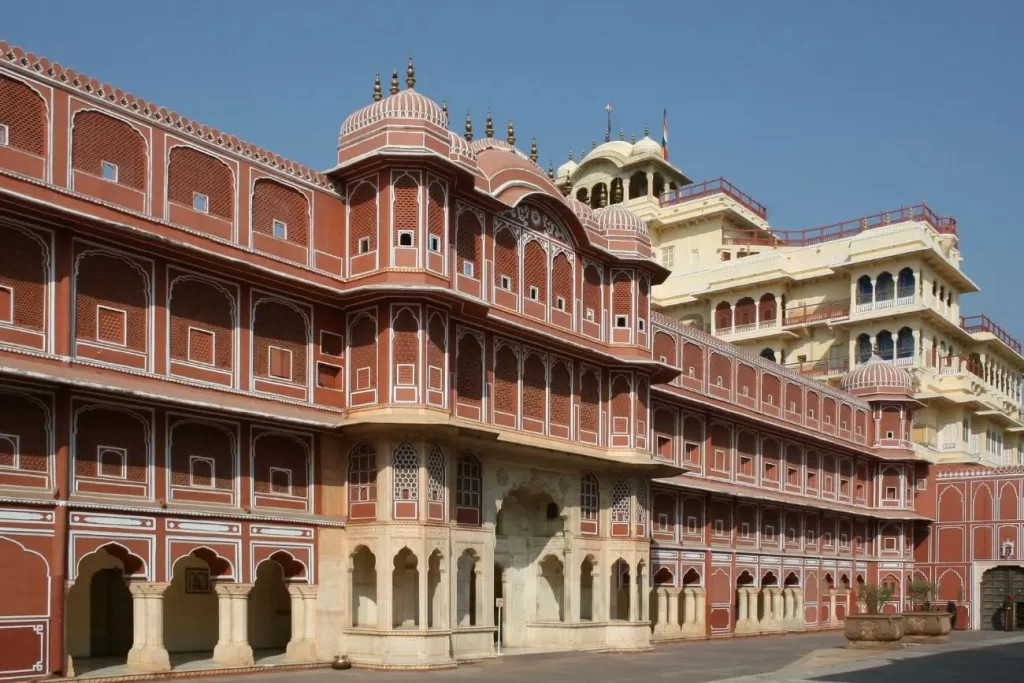
Built with a fusion of Rajputana and Mughal architecture, the City Palace is a royal residential palace and a popular tourist place in the city. The royal family of the city still resides in the luxury palace and a part of the palace is a Museum to be explored.
The lanes, walls, and audience halls speak volumes about the kingdom’s history and the city’s heritage. Small palaces (mahals) inside the City Palace complex are built in specific themes such as Chandra Mahal, Mubarak Mahal, and Sheesh Mahal.
These are adorned with fine pieces of precious and semi-precious stones. The ornate decoration on the walls and ceilings of the palace reminds of the opulent luxury life of the Rajasthani kings. A tour of City Palace is a must when in Jaipur as it provides an enriching cultural experience.
Jantar Mantar, Jaipur
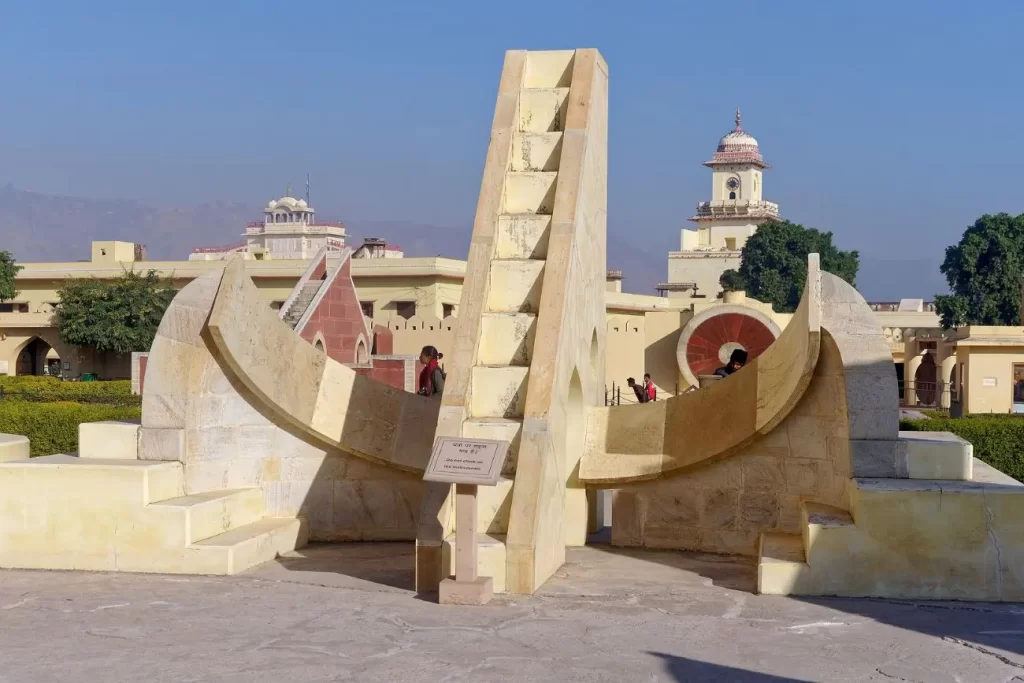
The Jantar Mantar is a pre-modern astronomical observatory in Jaipur. What’s admiring about the observatory is that it was built by the founder of Jaipur city who himself was fond of space science and astronomy.
There are numerous pieces of equipment built in Jantar Mantar which work on scientific principles and can measure time, predict eclipses, and track celestial bodies.
This early 18th-century astronomical observatory was ahead of its time and today is a UNESCO World Heritage Site and a popular tourist place in the city.
Hawa Mahal
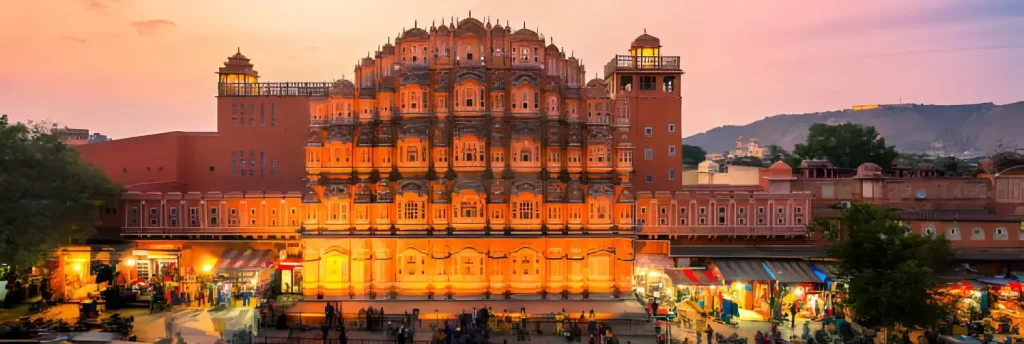
The Hawa Mahal is a palace built on the back side of the City Palace. It is a beautiful palace and also the epitome of Jaipur’s architectural heritage. The famous palace has more than 953 small windows which are called ‘Jharokha’s.
These Jharokhas are designed to let the cool breeze come inside from the small windows and the honeycomb design prevents the heat from entering the palace.
The palace can be viewed from the street adjacent to the City Palace. It is a famous landmark in the city and all visitors to the area stop by to click pictures.
Jaipur Old City

The Jaipur Old City is the heritage part of the city that was built during the foundational years of the city. All the buildings that form the Jaipur Old City are Red and orange. The streets offer views conducive to exquisite photography and videography. These streets are mostly bazaars where you can shop for jewellery, leather products, textiles, and handicrafts.
Nahargarh Fort
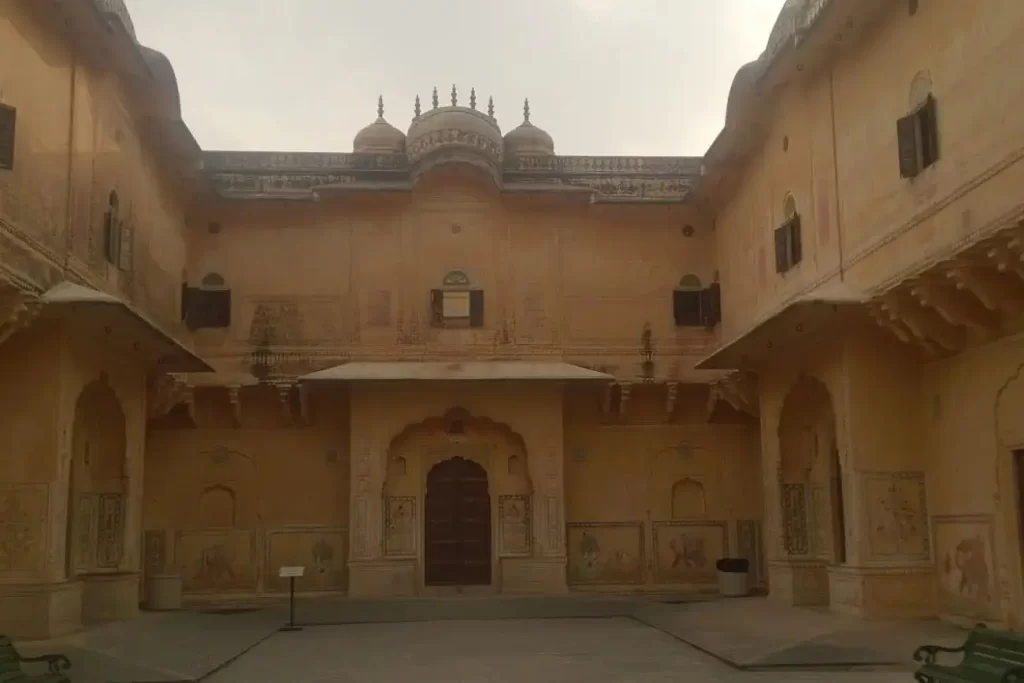
Nahargarh Fort is a citadel that once served as the defence ring of the Amer Fort. It is a beautiful fort that offers spectacular views of the Jaipur city. The iconic citadel was built in 1734 by the King of Jaipur Maharaja Sawai Jai Singh II. The sunrise and sunset views of the city from the fort are alluring to the eyes and deserve your attention.
Albert Hall Museum

The Albert Hall Museum is a popular attraction for visitors to the city. Known to be the oldest museum in the entire Rajasthan state, this museum keeps artefacts as evidence of the bygone era. The museum was built in Indo-Saracenic architecture and was opened in 1887. The museum is home to textiles, sculptures, paintings, ancient coins, and even an Egyptian Mummy.
Jaigarh Fort
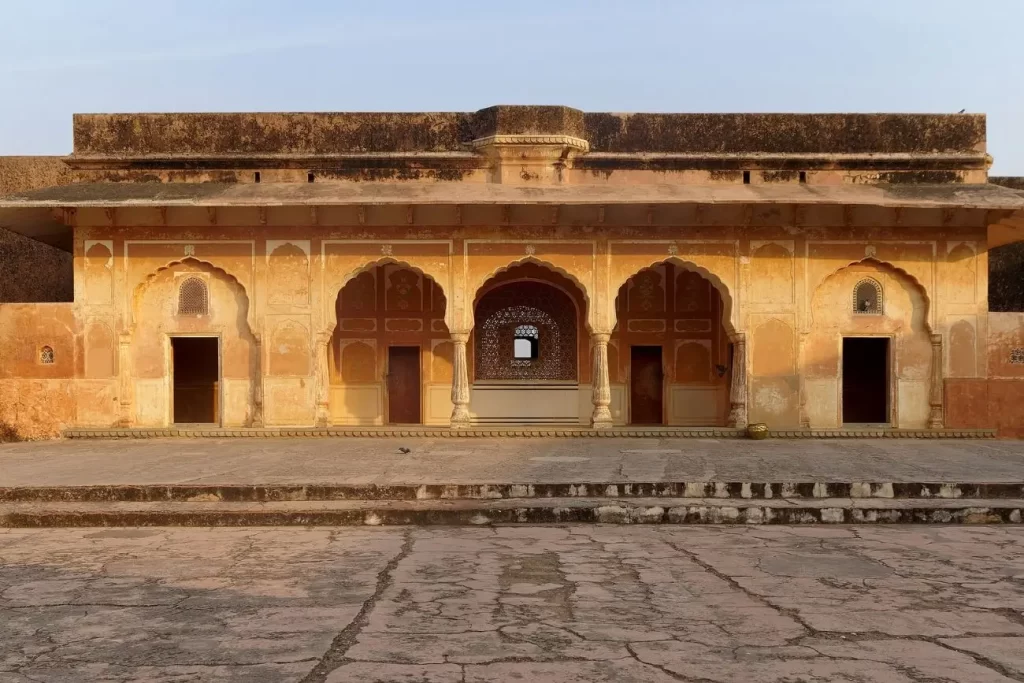
One of the grandest forts built above the magnificent Amer Fort is the Jaigarh Fort. It overlooks the Amer Fort and Maota Lake. The Jaigarh Fort is an architectural marvel that showcases the intricacy and bold looks of the Rajputana Architecture. Tourists admire the world’s largest cannon, ‘Jaivana’ which is placed on one of the rooftops of the fort.
Patrika Gate

Patrika Gate is a vibrant, multi-coloured gateway that stands as an artistic tribute to Rajasthan’s rich cultural heritage. Located at the entrance of Jawahar Circle Garden, this ornate gate features hand-painted murals depicting the history, traditions, and landmarks of the region. Each archway and panel is a canvas of intricate artwork, making Patrika Gate a visual feast for visitors. It’s an ideal spot for photography and a gateway to experiencing the artistic spirit of Jaipur.
Things to do on the Jaipur City tour
Monument Sightseeing
Jaipur city is one of the top picks for monument sightseeing in India. It lies on the Golden Triangle tourist circuit and millions of tourists visit the city to discover the architectural beauty of the city. There are numerous monuments such as forts, forts protecting other forts, step wells, royal palaces, grand entry gates, and museums in the city.
One gets to explore and cherish the rich history, heritage, cultures, and colours of this city. Jaipur is one of the World Heritage Cities and a tour of the city is a wholesome experience of the Indian culture and heritage.
Walk across Jaipur Old City
Jaipur’s old city is a beautiful part of the Jaipur heritage. You’ll see that all the buildings in the Jaipur Old City are in a unique shade of Red, Orange, and Pink. The entire town of Old Jaipur looks spectacular and in sync with each other; thus elevating the opportunities for Indian street photography.
There are bazaars with leather products, Indian ethnic wear, and apparel as well as exquisite jewellery for women. The vibes are real and will certainly raise the shopper in you.
Spend a pleasant evening with Jal Mahal view
The Jal Mahal is a beautiful palace amidst the Man Sagar Lake that’s iconic in the city and is visited by a flock of visitors. The palace is closed to the public but one can enjoy serene views of the palace from the banks of the lake.
On the backside of the palace, you’ll see the Aravalli mountain ranges that will elevate the landscape views altogether. The Rajputana-styled palace looks spectacular in its shade of Yellow and turns magnificent when the lights light up in the evening.
Cultural retreat at Chokhi Dhani
Visit Chokhi Dhani in Jaipur and immerse yourself in the cultural beauty of Rajasthan. This artificially made village is a representation of Rajasthani culture, traditions, rituals, cuisine, and lifestyle. A visit to this place is a must where you get the best of hospitality, and delectable Rajasthani cuisine, and experience cultural shows, puppet shows, and live music.
There are hangout places inside the complex where you’ll see temples, caves, mazes, rides, and depictions of India’s temples. Further, there are traditional Rajasthani Restaurants and a National Museum that is a treasure chest of Rajasthan’s lifestyle.
Discover local markets and bazaars
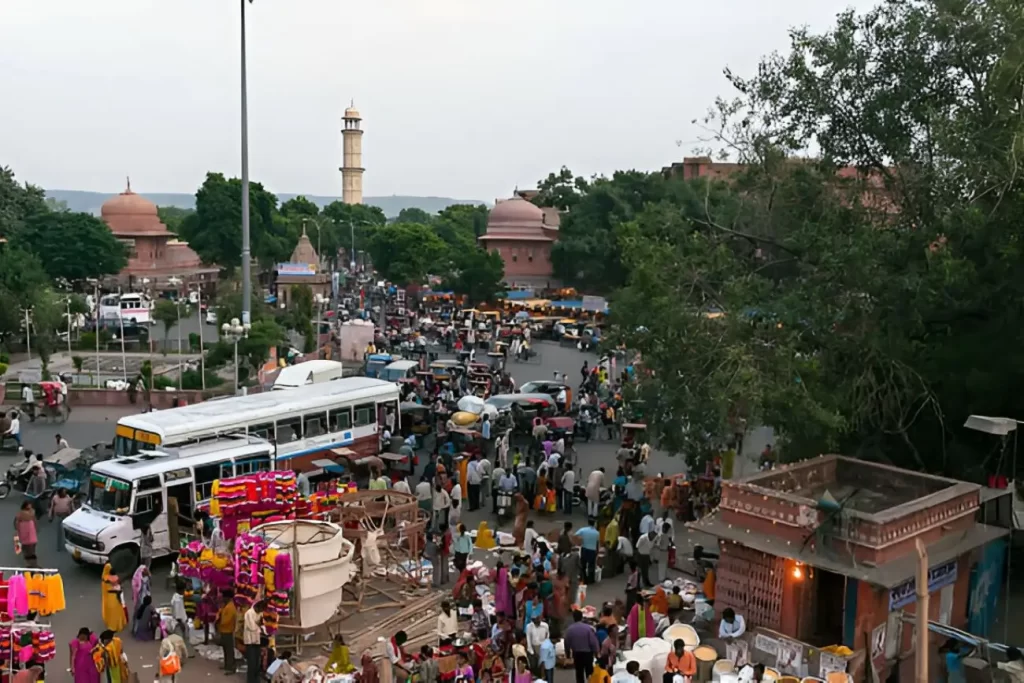
The local bazaars and markets of Jaipur are a major highlight of the city; thus making the city tour more intriguing and interesting.
Popular markets of Jaipur –
- Sireh Deori Bazaar – Popular for puppets, textiles, Jaipuri quilts, and leather shoes
- Johari Bazaar – Popular for precious stone Jewellery such as Gold, Diamond, Rubies and Emerald. Also famous for Rajasthani wedding dresses, and sarees.
- Tripolia Bazaar– One of the oldest markets in the city famous for Lac Bangles and jewellery, carpets, and rugs.
- Bapu Bazaar – Popular for Mojari footwear products.
- Gangauri Bazaar – Popularly known for wooden handicrafts, furniture, and decorative items.
- Relish authentic Rajasthani cuisine: Rajasthani Cuisine is a delight to the tastebuds as the cuisine is all about the infusion of a range of spics and flavours. Be it Veg or Non-Veg, the cuisines have exotic dishes and Thali’s which are a treat to the tastebuds.
You can find some really good Rajasthani restaurants in the city where you can relish the authentic taste of Rajasthan.
Planning a Jaipur Tour
When to visit Jaipur –
Monsoon time: June to September
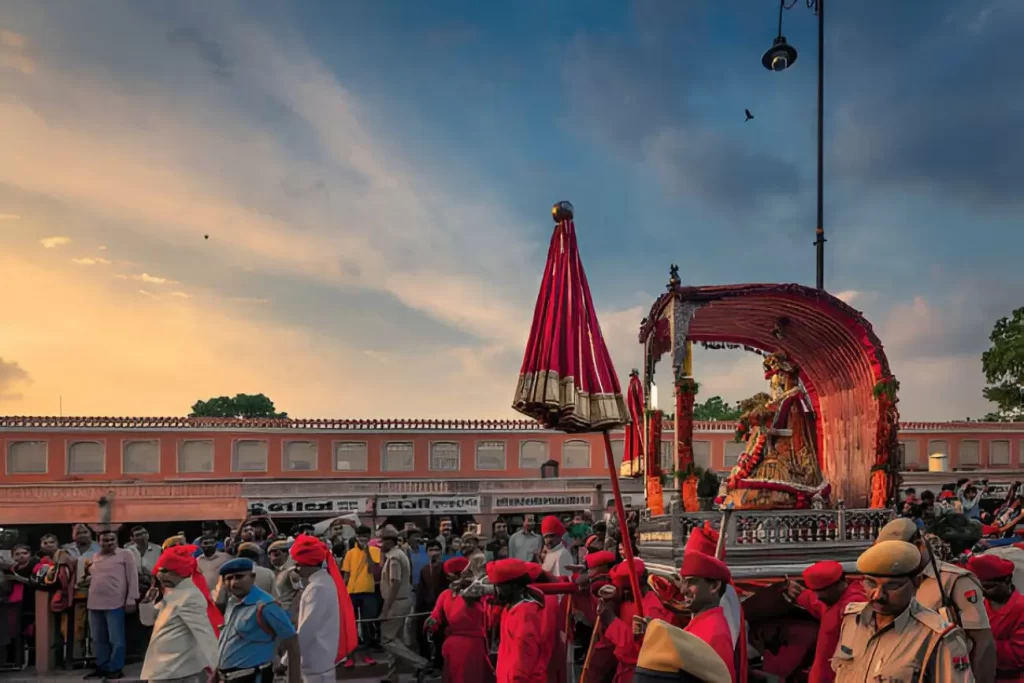
During the monsoon season, there are around 600 millimetres of average rainfall. However, the weather is largely hot and humid during these months. The tourist crowd is less during these months but there are certainly off-season discounts during these months.
Tips for Jaipur tour during Monsoon
Wear light breathable clothes if you are travelling to Jaipur during the monsoon months of June to September. Carry a refillable water bottle as hot and humid weather can create trouble at times.
Festivals to catch during Monsoon season
Teej: The Teej festival is celebrated with zeal and joy in Jaipur. Both women and men wear traditional outfits and keep fast during this day. There is a great celebration, folk dances, and cultural shows during this festival.
Autumn time: October to November
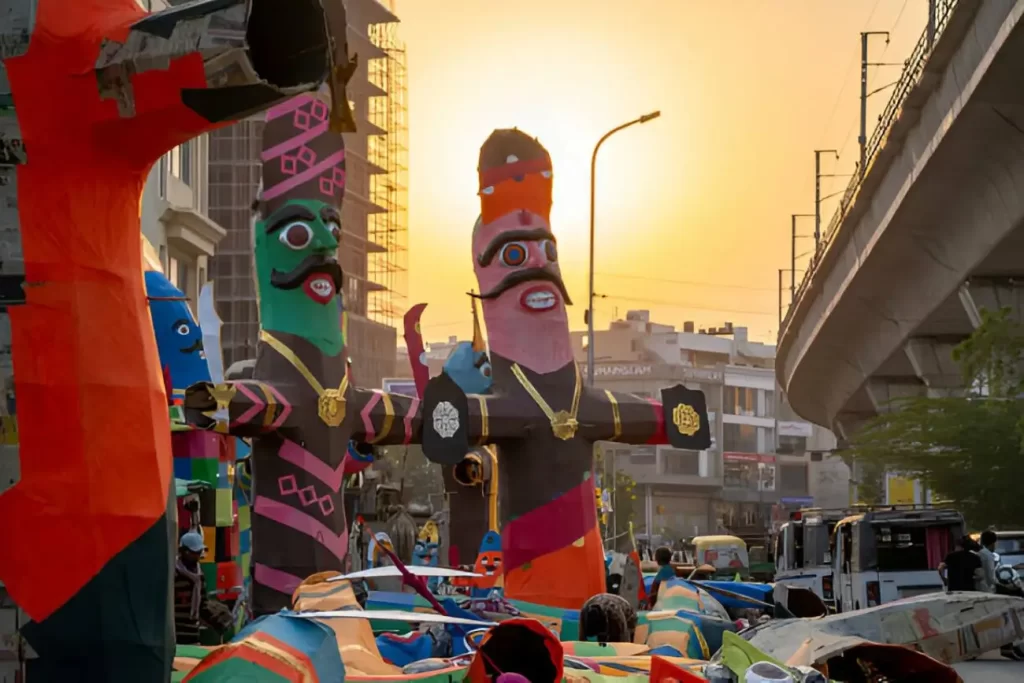
You’ll have a splendid experience of the Pink City during these months. This is a post-monsoon season and the weather is clean and bright. The daytime is slightly warm but the dusk and dawn are pleasant. Enjoy a stroll across the beautiful streets of the city in the evenings and enjoy the vibrancy of the city.
Tips for Autumn season in Jaipur
The daytime can be slightly warm. Hence, carry a water bottle and wear light clothing.
Festivals to catch during the Autumn season
Dusshera: The Dusshera is a popular Hindu festival where the effigy of Ravana is lit by the depicted Hindu God Rama. Dusshera is an iconic festival celebrated across India with full enthusiasm. You’ll have a great time in Jaipur if you are around in the city during these months.
Winter time: December – February
The winters of Jaipur are awesome and the city turns into a very happening one. The weather is cold though not very cold, but pleasant. The minimum temperature remains around 4-5 degrees Celcius. You can stroll across the monuments while basking in the sun post a cold morning. The mornings and evenings are colder compared with the daytime.
Festivals and activities
This is the best time to be in the city and become a part of the grand celebration of Diwali or Deepawali. It is the biggest Hindu festival just like Christmas in the West. The festival of Diwali is also called ‘the festival of Lights’. People decorate their homes and lit earthen lamps or Diyas in their homes. People indulge in Puja at home cook delicious dishes and savour them with sweets and desserts.
Hence, the winter months are the best time to explore Jaipur city.
Tips for visiting Jaipur city during the Winter season
Carry warm clothes for the winter season. The cold is not extreme but can be spine-chilling during the night. Also, carry a face mask if you are visiting during Diwali. The bursting of crackers causes smoke. Thus, can cause discomfort. Keep a face mask with you for caution.
Springtime: March-April
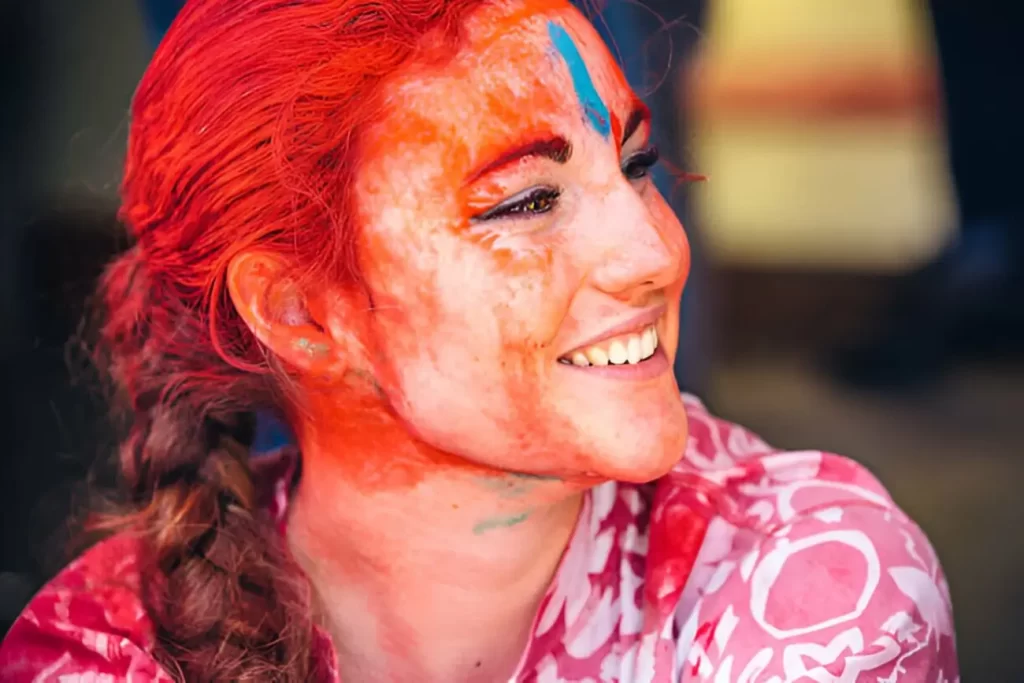
Springtime is certainly the sweet spot time to visit the beauty of Jaipur. The weather is pleasant, trees are shedding their leaves, and the festival of Holi (festival of colours) is around. This time is suitable for sightseeing as it is neither very cold nor very hot during the day. Stroll across the local markets of the city and shop for your favourite souvenirs.
Festivals and Events
Holi: The date of the Holi festival usually surfs between February, March, and April as per the Hindu calendar. However, most of the time the festival of Holi lies in March and April. This is one of the best and most joyous festivals celebrated across the country. If you want to experience it, plan your tour around the festival.
Gangaur Fair: The Gangaur festival is a religious festival that’s celebrated across Rajasthan and some other parts of India with full devotion. There are cultural shows and processions across the state and it is worth witnessing it.
Summertime-May-June
The summer months are certainly not suitable for visiting the city as scorching heat takes over the city. The temperature can rise to 46°C (114 °F), not conducive to staying outdoors. Though, you can get good discounts on accommodations, taxis and tour packages.
Tips to follow while travelling to Jaipur in the summers
Wear loose comfortable clothes and carry a refillable water bottle to stay hydrated.
Travel tips when visiting Jaipur
Clothing
- Summer – Wear light-coloured cotton clothes that are breathable and comfortable.
- Winter – Wear warm clothes and you’ll be good!
Interaction and communication
People largely speak Hindi for communication. However, they understand conversational English as well. As a foreign traveller in India. communicating in English with the vendors, and locals won’t be a problem.
Transportation and accommodation
Jaipur is a modern metropolis and commuting from one place to another won’t be a hassle. The city has a modern Metro system, Air Conditioner buses, cabs and Tuk Tuk’s. Pro-tip: Take cabs, buses and metro for long distances. Take Tuk Tuk, rickshaws for short distances.
Photography and Videography
The city of Jaipur is a treasure to be discovered by photographers and videographers. The Jaipur Old City, the historical monuments, and the Patrika Gate offer amazing opportunities to test your aperture and ISOs. Some monuments in the city may have prohibition guidelines on photography.
Shopping and Bargaining
The city is a paradise for shoppers as the rich history and heritage of the city can be seen in literally any of the things you see in Jaipur. Mojari footwear, leather bags, wooden artefacts, or gem jewellery, are some of the top souvenirs you must take from Jaipur. These will be a remembrance of one of the most beautiful Indian cities you visited.
Best Jaipur Tour Packages
Same-day Jaipur tour
If you opt for a Private Jaipur tour, the tour will begin from your pickup in the city. The driver assigned to your tour will come to pick you up from the airport/railway station or hotel. On this one-day trip, you will explore Amer Fort, City Palace, Jantar Mantar, and Hawa Mahal. You’ll get lunch breaks and facility breaks in between. A Same-day Jaipur tour is suitable for those who want to explore more in less time in a budget-friendly setting. However, to experience the city more comprehensively, a minimum 2-day tour is recommended.
2 Day Jaipur City Tour from Delhi
Planning a Jaipur tour from Delhi is also a preferable choice for tourists. The reason is, that Delhi International Airport has flights from around the world. Hence, it is convenient plus, you’ll get to see a glimpse of India’s capital as well.
On the first day of the tour, you’ll be welcomed at New Delhi airport and will be transferred to Jaipur city. It usually takes 4-5 hours to reach Jaipur. Sit back, relax, and enjoy the scenic views en route to the ‘Pink City of India. Check-in the hotel and head out for sightseeing. Visit City Palace, Hawa Mahal, Jantar Mantar, and Albert Hall Museum in the evening.
Next day, visit the grand Amer Fort while enjoying the panoramic views of the Jal Mahal. Drive past Nahargarh Fort as you descend back to the city. Conclude the tour by getting back to New Delhi by evening.
Golden Triangle Tour from Delhi
The Golden Triangle Tour is a very detailed tour of three iconic Indian cities – Delhi, Agra, and Jaipur. The tour starts from New Delhi and after a storied sightseeing experience of India’s capital, will reach the city of Taj Mahal, Agra. Agra is a beautiful place where the Mughal emperor Shah Jahan built the architectural marvel Taj Mahal which has admirers from all around the world.
Along with the Taj Mahal, you’ll also visit Red Fort (Royal residence of the Mughal Empire), Itimad-Ud-Daulah, and Mehtab Bagh.

